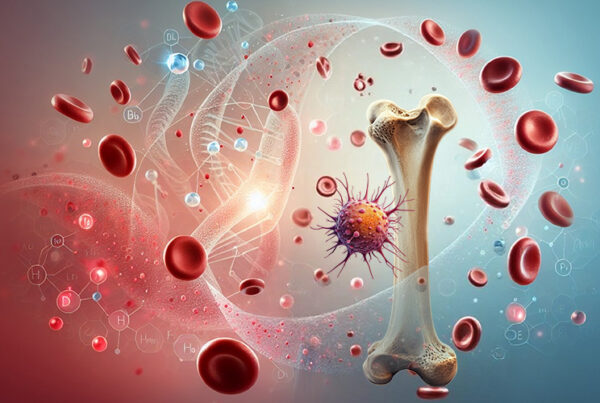
Introduction
Multiple myeloma is a type of blood cancer that affects plasma cells, which are found in the bone marrow. But did you know that a study says smoldering multiple myeloma occurs in around 0.53% aged 40 and above? Additionally, current clinical risk stratification models state that one-third of patients suffering from SMM have a higher chance of developing multiple myeloma.
So what is smoldering multiple myeloma? Is smoldering multiple myeloma considered cancer? What are the smoldering multiple myeloma symptoms and treatment options? Let’s decipher in this guide.
What is Smoldering Multiple Myeloma?
First, it is important to know what is smoldering multiple myeloma. Smoldering is an asymptomatic stage of multiple myeloma. You can think of it as the pre-stage of multiple myeloma where the patient cannot experience any symptoms.
This condition is characterized by the presence of abnormal plasma cells in the bone marrow. Although the condition is degrading your organs from within you will not be able to feel it. So, is smoldering multiple myeloma considered cancer?
Well, the answer is quite complicated. We will explain this in the section below. Talking about oncology, here is a brief guide to what is oncology research.
What Happens in Smoldering Multiple Myeloma?
SMM isn’t quite cancer yet, it’s considered a precancerous condition. However, it has the potential to progress into full-blown multiple myeloma, which is a type of cancer. Smoldering myeloma lies in a middle ground, where abnormal cells are present but haven’t yet caused major harm to your body. However, with progression time, it could get worse.
You can identify SMM through specific changes in your body like:
- Levels of monoclonal protein (M protein) in your blood at 3 grams per deciliter (g/dL) or higher.
- An increase in plasma cells within your bone marrow (where red blood cells are produced), ranging from 20% to 60%.
One key aspect of SMM is that you don’t experience the typical symptoms of active multiple myeloma like
- Kidney damage or reduced kidney function.
- Anemia (low red blood cell count).
- High calcium levels in your blood, usually come from bone damage.
- Bone lesions or fractures.
Although SMM progresses slowly, it can worsen over time. Initially, the number of plasma cells in your bone marrow may stay stable, but eventually, they could increase. At some point, damage to your kidneys or bones may begin. However, it’s often so mild that you won’t notice any symptoms right away.
Living with smoldering myeloma can also put you at risk for other health complications, such as:
- Peripheral neuropathy – which causes numbness or tingling in your hands and feet.
- Osteoporosis- or brittle bones that are more prone to fractures.
- Infections- due to the weakened immune system.
While smoldering multiple myeloma doesn’t cause immediate damage, monitoring its progression and understanding the risks can help you stay proactive about your health.
Also Read: What is Bone Marrow Edema: Signs, Treatment and What to Expect
Is Smoldering Multiple Myeloma Considered Cancer?
Is smoldering multiple myeloma considered cancer? It is complicated.
SMM shares many symptoms of active cancer. Symptoms like the presence of abnormal cells, it is not classified as active cancer because it does not yet cause the damage associated with cancerous diseases. However, SMM can progress to full-blown multiple myeloma over time, which is why monitoring and early detection are crucial.
Early Signs and Risk Stratification
One of the main challenges with SMM is that it often has no symptoms. Most patients are diagnosed with this condition casually during routine blood tests. The tests might show elevated levels of monoclonal protein (M-protein) or abnormal plasma cells in the bone marrow. Because there are no obvious smoldering multiple myeloma symptoms, it may go undetected for years.
However, there are certain biomarkers that doctors use to identify and stratify the risk of progression from smoldering myeloma to active multiple myeloma. For example, the International Myeloma Working Group (IMWG) outlines specific criteria for SMM diagnosis, including:
- M-protein levels of at least 3 grams per deciliter.
- 20-60% abnormal plasma cells in the bone marrow.
- No evidence of organ damage.
Once diagnosed, SMM is categorized into low-risk, intermediate-risk, and high-risk groups based on several factors. These factors include genetic mutations and the extent of bone involvement. Moreover, those in the high-risk category are more likely to develop active multiple myeloma within a few years.
Read More: Is Multiple Myeloma Hereditary?
Progression from Smoldering to Active Multiple Myeloma
The progression of SMM to symptomatic multiple myeloma is a major concern. On average, about 10% of SMM cases evolve into active myeloma each year, although this risk can vary depending on the risk category. Moreover, several factors contribute to this progression, including genetic mutations, increased bone marrow involvement, and the levels of M-protein in the blood.
Early intervention may help delay or even prevent the progression to active multiple myeloma in some high-risk patients. However, because SMM itself is asymptomatic, the decision to treat or monitor requires careful risk assessment. That’s why it is recommended for individuals diagnosed with SMM to undergo regular monitoring through blood tests and imaging scans to catch any signs of disease progression early.
What are the Diagnosis and Tests?
Your doctor might first notice signs of SMM during routine lab tests. For example, a blood or urine test may reveal elevated levels of M protein, or a blood test could show an increased number of plasma cells. These results could be early indicators of smoldering multiple myeloma, even if you’re not experiencing any symptoms.
To diagnose smoldering multiple myeloma, your doctor may prescribe the following tests:
- Serum protein electrophoresis: This test measures the levels of specific proteins in your blood, helping to detect abnormal M protein.
- Complete blood count (CBC): A CBC checks the levels of different types of cells in your blood, including red and white blood cells and platelets.
- Serum calcium and creatinine tests: These tests assess your calcium levels (to check for bone damage) and creatinine levels (to monitor kidney function).
- Urine test: Your doctor may ask you to collect urine over 24 hours to check for protein levels. This may be repeated 2 to 3 months later to track any changes.
In addition to blood and urine tests, other procedures can help confirm the diagnosis:
- Bone marrow biopsy: Using a needle, your doctor will take a small sample of bone marrow from inside your bone to check for the presence of myeloma cells.
- Skeletal survey: This series of X-rays examines all your bones to detect any abnormalities or signs of bone damage.
- MRI: An MRI scan, particularly of the spine and pelvis, can provide detailed images that may reveal bone lesions or other damage. MRIs are often more effective than X-rays at detecting early signs of bone problems.
Smoldering Multiple Myeloma Treatment Options
Watchful Waiting (Active Surveillance)
For low-risk or intermediate-risk patients, a watchful waiting or active surveillance approach is often recommended. In this case, no immediate treatment is given, but the patient is monitored closely through regular blood tests, bone marrow biopsies, and imaging studies.
Early Intervention Trials
For high-risk patients, early intervention is sometimes considered, especially for those who have a higher chance of progression to symptomatic disease within two years. Clinical trials exploring the use of drugs like lenalidomide (a type of immunomodulatory agent) have shown promising results in delaying the onset of active myeloma in high-risk patients.
Clinical Trials
Many Multiple Myeloma clinical trials are being conducted to find a better therapeutic option. The trials require your active participation and head-on finding a better cure option. So, find active clinical trial recruitment and enroll today. You can know the importance of clinical trials through the fact that every new drug or instrument released in the market requires active trials and optimal results from them.
Do you want to know about decentralized clinical trials, here’s a guide.
Conclusion
To conclude, SMM is a precancerous stage of multiple myeloma which shows no symptoms. The doctor may prescribe certain tests for diagnosis and then prescribe the optimal therapy.
NHO Revive is your trusted platform for patient-centric clinical research. It focuses on conducting efficient clinical trials for oncology and hematology while focusing on improved patient care. So, join us today.







